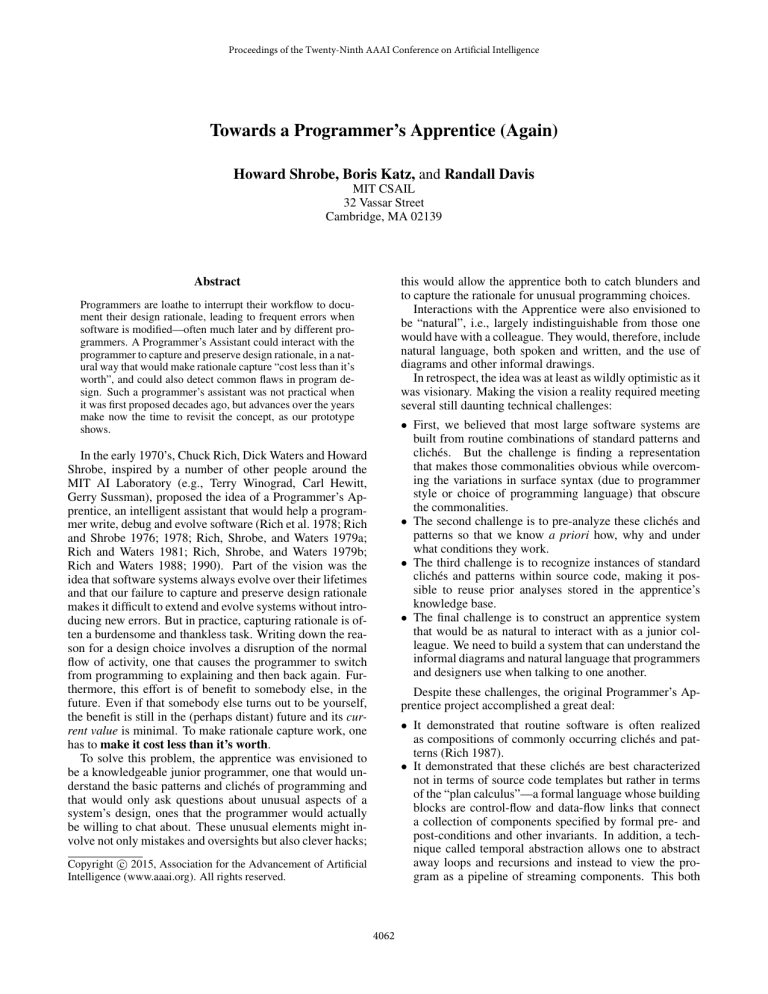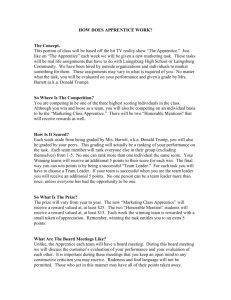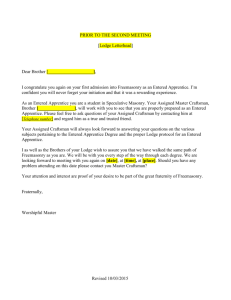
Proceedings of the Twenty-Ninth AAAI Conference on Artificial Intelligence
Towards a Programmer’s Apprentice (Again)
Howard Shrobe, Boris Katz, and Randall Davis
MIT CSAIL
32 Vassar Street
Cambridge, MA 02139
Abstract
this would allow the apprentice both to catch blunders and
to capture the rationale for unusual programming choices.
Interactions with the Apprentice were also envisioned to
be “natural”, i.e., largely indistinguishable from those one
would have with a colleague. They would, therefore, include
natural language, both spoken and written, and the use of
diagrams and other informal drawings.
In retrospect, the idea was at least as wildly optimistic as it
was visionary. Making the vision a reality required meeting
several still daunting technical challenges:
Programmers are loathe to interrupt their workflow to document their design rationale, leading to frequent errors when
software is modified—often much later and by different programmers. A Programmer’s Assistant could interact with the
programmer to capture and preserve design rationale, in a natural way that would make rationale capture “cost less than it’s
worth”, and could also detect common flaws in program design. Such a programmer’s assistant was not practical when
it was first proposed decades ago, but advances over the years
make now the time to revisit the concept, as our prototype
shows.
• First, we believed that most large software systems are
built from routine combinations of standard patterns and
clichés. But the challenge is finding a representation
that makes those commonalities obvious while overcoming the variations in surface syntax (due to programmer
style or choice of programming language) that obscure
the commonalities.
• The second challenge is to pre-analyze these clichés and
patterns so that we know a priori how, why and under
what conditions they work.
• The third challenge is to recognize instances of standard
clichés and patterns within source code, making it possible to reuse prior analyses stored in the apprentice’s
knowledge base.
• The final challenge is to construct an apprentice system
that would be as natural to interact with as a junior colleague. We need to build a system that can understand the
informal diagrams and natural language that programmers
and designers use when talking to one another.
In the early 1970’s, Chuck Rich, Dick Waters and Howard
Shrobe, inspired by a number of other people around the
MIT AI Laboratory (e.g., Terry Winograd, Carl Hewitt,
Gerry Sussman), proposed the idea of a Programmer’s Apprentice, an intelligent assistant that would help a programmer write, debug and evolve software (Rich et al. 1978; Rich
and Shrobe 1976; 1978; Rich, Shrobe, and Waters 1979a;
Rich and Waters 1981; Rich, Shrobe, and Waters 1979b;
Rich and Waters 1988; 1990). Part of the vision was the
idea that software systems always evolve over their lifetimes
and that our failure to capture and preserve design rationale
makes it difficult to extend and evolve systems without introducing new errors. But in practice, capturing rationale is often a burdensome and thankless task. Writing down the reason for a design choice involves a disruption of the normal
flow of activity, one that causes the programmer to switch
from programming to explaining and then back again. Furthermore, this effort is of benefit to somebody else, in the
future. Even if that somebody else turns out to be yourself,
the benefit is still in the (perhaps distant) future and its current value is minimal. To make rationale capture work, one
has to make it cost less than it’s worth.
To solve this problem, the apprentice was envisioned to
be a knowledgeable junior programmer, one that would understand the basic patterns and clichés of programming and
that would only ask questions about unusual aspects of a
system’s design, ones that the programmer would actually
be willing to chat about. These unusual elements might involve not only mistakes and oversights but also clever hacks;
Despite these challenges, the original Programmer’s Apprentice project accomplished a great deal:
• It demonstrated that routine software is often realized
as compositions of commonly occurring clichés and patterns (Rich 1987).
• It demonstrated that these clichés are best characterized
not in terms of source code templates but rather in terms
of the “plan calculus”—a formal language whose building
blocks are control-flow and data-flow links that connect
a collection of components specified by formal pre- and
post-conditions and other invariants. In addition, a technique called temporal abstraction allows one to abstract
away loops and recursions and instead to view the program as a pipeline of streaming components. This both
Copyright c 2015, Association for the Advancement of Artificial
Intelligence (www.aaai.org). All rights reserved.
4062
data mining. It is plausible that machine learning techniques can be applied to software repositories to capture common patterns, thereby automatically populating
at least some of the knowledge base of the apprentice.
makes many commonalities more obvious and facilitates
formal analysis (Waters 1979; Rich 1984; Shrobe 1979;
Waters 1988; 1991; 1978).
• Finally, the original project demonstrated that it is possible to recognize instances of standard clichés and patterns within source code, making it possible to understand
how and why a module works, by combining the analyses
of the clichés (Rich and Wills 1990; Wills 1992; 1990;
Clayton, Rugaber, and Wills 1998; Wills 1996).
Finally, the nature of the programming activity itself
has changed enormously, making the availability of an
apprentice-like system much more valuable:
• Today’s software developers spend much of their time
scouring open source repositories and interacting with experts via the internet (e.g., stackoverflow.com). But how
much does that help us? Can we find what we need
quickly? From what’s available, can we tell whether
some specific instance is going to meet our needs or even
whether it’s correct? Usually not.
• Programmers now work mainly in teams, and the average
life of a programmer on a project is quite short. Preserving the reasons for design decisions and other forms of
rationale is now a critical, not an optional, task.
• Much of programming today involves gluing together
components of large frameworks rather than coding from
scratch. Understanding the protocols for using these
frameworks is necessary for using them appropriately.
The rules for using a protocol are often best illustrated
through examples and counter-examples. But finding
such examples is often difficult, largely due to the low
level of semantics employed in searching. Analyzing the
examples in a repository and representing them in a semantically richer manner, such as that used in the Programmer’s Apprentice, might make the task easier.
• Building and maintaining a complex, long-lived application involves a large number of tools and specialties,
including: system design, functional requirements, security requirements, web frameworks, object–database mapping, software (update) delivery, license management, integration, testing, and verification. Much of the data management involved in sustaining such activities might well
be better accomplished by an intelligent assistant.
Looking forward
Despite these intellectual successes, the Apprentice project
didn’t achieve its vision of providing a practical, knowledgerich programmer’s assistant. But there is reason to believe
that it’s time to revisit the concept, primarily because the
technologies we can build on today are much more mature
than were those of the 1970’s:
• Computers are roughly 50,000 times more powerful on
every relevant dimension than in the early 1970’s. This
has enabled techniques to be used in practice today that
were unthinkably slow at that time.
• Our technologies for formal analysis of software are
reaching practicality. Theorem proving and other formal methods have improved to the point where we can
construct formal proofs of the correctness of operating
system micro-kernels. Furthermore, many of today’s
advanced theorem proving systems (e.g., ACL2, Coq)
include programming languages for expressing theorem
proving “tactics”. This allows us today to associate with
every programming cliché a set of tactics for deriving
proofs of the desirable properties of that cliché.
• It’s much easier to build the kinds of symmetric, multimodal interfaces that facilitate natural interactions between programmers and an apprentice system. We have
systems that routinely understand natural language (Katz
et al. 2007; Katz, Borchardt, and Felshin 2006; 2005;
Katz 1997) and sketches (Alvarado, Oltmans, and Davis
2002; Alvarado 2000; Alvarado and Davis 2006; Alvarado 2007; Hammond and Davis 2006; Sezgin, Stahovich, and Davis 2006; Adler 2003; Hammond et al.
2002; Stahovich, Davis, and Shrobe 1998; 1995).
• A large subset of all the software in the world is now available online in repositories that include source and object
code, version histories, test cases, build scripts, etc. Vast
stores of software are available in online open repositories. To first order, if you need a routine to accomplish a
specific task, then, with high probability, there is a piece
of software somewhere in one of those repositories that
can do the job. If you want an example of something,
it’s probably out there somewhere. If you have just made
a mistake in your code, it’s likely that someone else has
made a similar mistake, has checked in a fix to that mistake, and both versions are available in a version control system. If you are trying to prove a property about
your system, it is increasingly likely that similar properties have been proven about similar systems.
• Machine Learning technology has greatly advanced, making it easier, in some cases, to acquire knowledge through
All this highlights the pressing need to capture semantically rich annotations to software systems, and the need
to maintain relationships between all the artifacts associated
with a software system over time. This in turn raises many
new questions and challenges:
• How do we formally represent and organize high-level design artifacts? How do these relate to both requirements
and implementation artifacts? How have these designs
changed over time?
• How do we manage the evidence that a particular implementation correctly implements all of (and only) the requirements and policies for the application? Are there
formal proofs of correctness, and if so, how do we represent them in a way that facilitates reuse? Are there test
suites, and if so, what is the coverage, of both requirements and source code?
• What is the end-to-end certification case for the correctness of the software system?
• How can all of these artifacts and rationale be maintained
over time? As requirements change, or source code is
4063
Figure 1: The Apprentice Catches A Blunder
The user begins by telling the Apprentice that there is an
“imager” component of the system. The dialogue that ensues is as follows:
updated, or even the tool-chain is updated, how is the certification case re-checked?
• Are there idioms, clichés, and patterns at all of these levels, not just at the implementation level? For example,
constructing formal proofs has evolved to be more like
software development. Are there proof clichés and patterns, and what is the relationship between the patterns
and clichés used in a piece of software and those used in
its proof?
• Can we make interaction with our design and implementation tools so natural that valuable information that is today routinely lost would instead be captured and made
available?
User: (selecting a box in the drawing) This thing is an imager.
Apprentice: I don’t know what an imager is; can you tell
me about imagers?
User: Imagers are input devices.
Apprentice: What type of output does an imager produce?
User: Images.
At this point the apprentice updates its ontology to include
an entry for “imager”, situating that entry under “input device”. The apprentice asks about the type of the output produced by an imager because it already knows that any input
device produces an output, but it has no further information
about the type of output produced by input devices in general. The apprentice updates its entry for imagers, noting the
type restriction on the output of imagers. It doesn’t query
any further because it already knows what an image is: it’s
an array of pixels. It also already knows that pixels can be
viewed as a sequence of bytes.
Next the user adds a disk drive to the drawing and draws
an arc connecting the output of the imager to the input of the
disk drive. At this point the apprentice interrupts the user,
pointing out that this is a mistake:
A Scenario
As a step toward understanding how we might proceed in
today’s world, we have begun construction of a prototype
apprentice system and have implemented enough functionality to conduct a simple design exercise with a user. In ths
section, we will describe a part of that interaction, showing
the system as it currently performs.
The current prototype interacts with its user using spoken
language and a simple GUI interface for drawing. Spoken
language is captured using the SIRI programmatic interface
(on a MacBook) and is then parsed using an HTTP-based
interface to the START natural language system (Katz, Borchardt, and Felshin 2006; 2005; Katz 1997). START returns
the parse as a set of subject–relation–object triples. Similarly, to generate spoken output, the system sends a set of
triples to START, asks it to produce text and then passes the
generated text to the built-in text-to-speech system.
The prototype also contains a modest-sized ontology. It
knows, for example, that:
Apprentice: You can’t connect the output of the imager to
the input of the disk drive. Imagers produce images, which
are arrays of pixels, but disk drives consume buffers which
are vectors of bytes. (See Figure 1.)
User: Insert a transducer.
The apprentice updates the drawing by adding a new box,
labeled “transducer” and redraws the arcs so that the output
of the imager goes into the transducer while the output of
the transducer goes into the disk drive. The drawing is also
updated to show the required types of all the data flowing
through the system. (See Figure 2.)
Next the user asks the apprentice to synthesize the code
for the transducer. The apprentice doesn’t actually know
how to do this task directly, but it is able to use its reasoning
capabilities as follows:
• There are data-structures and computations.
• Sets, sequences, and mappings are types of collections,
and collections are data structures.
• A sequence can be either a data structure (distributed in
space) or a stream of values (distributed in time).
• An array can be viewed as either a sequence of rows or
as a sequence of columns, and rows and columns can be
viewed as vectors.
• There are standard clichés for iterating over sequences of
values and for accumulating values into a container.
• There are input and output devices that produce and consume data of specific types.
• The goal is to transform an image (an array of pixels) into
a disk buffer (a vector of bytes). One way to do this is to
employ a standard “generate and accumulate” cliché.
• The prerequisite for using this cliché is that the type of the
output produced by the generator be a subtype of the type
of the accumulator’s input.
• Pixels aren’t a subtype of bytes, but a pixel can be viewed
Our prototype’s design session deals with the construction
of a software system that manages a sensor carried on an
airborne vehicle. The initial design goal is to capture and
store the outputs of the sensor.
4064
Figure 2: The User Asks the Apprentice to Insert a Transducer
Summary
as a vector of bytes (in either “big-endian” or “littleendian” order). So a second generator is inserted to transform the stream of pixels into a stream of bytes.
• One way to do that is using a standard generator cliché for
linear structures. (The fact that vectors are linear structures is already in the apprentice’s ontology.)
• Unfortunately, the apprentice also doesn’t know how to
generate the elements of an array. However, it does know
that an array can be viewed either as a vector of rows or
as a vector of columns. Furthermore, columns and rows
can both be viewed as vectors. The apprentice, therefore,
refines the design of the array generator into a cascade
of two more instances of the cliché for generating linear
structures; the first generates the rows (or columns) and
the second generates the elements of each row (or column).
In this simple scenario we illustrated our initial efforts on
the following points:
• The apprentice can interact in a natural manner using language and sketches of a sort similar to that of a human.
• The apprentice can learn through interactions with the
user.
• The apprentice can discover and capture design rationale.
• The apprentice can catch simple blunders made by the
user.
• The apprentice can take on routine coding tasks.
Earlier we noted that there a large number of other tasks
that we might like an apprentice to undertake for us. Perhaps
attacking all these issues would be as much of a “blue sky”
effort today as was the original Programmer’s Apprentice
project. But it is one that brings together diverse areas of
Artificial Intelligence in the service of an important need.
However, the apprentice has no reason for choosing one
order of traversing the array over the other. It therefore
queries the user:
Apprentice: I’m trying to generate the elements of the array.
I can do this in row-major or I can do this in column-major
order. Which do you prefer?
User: Row-major.
Apprentice: What is your reason?
User: Row-major is more efficient. Rows are stored contiguously. So traversing in row-major order gives greater
cache locality.
Figure 3: The Generated Code
The apprentice records both the particular choice made
as well as the design rationale for it (i.e., it’s more efficient). It also learns that there is usually a reason for preferring row-major order and this fact is added to its knowledge base. Similarly, there is a choice to be made as to
whether to generate the bytes of each pixel in “big-endian”
or “little-endian” order. The programmer chooses “littleendian” since this is the standard convention for information
either in transit or in persistent storage. Again the choice
and its rationale are captured and the background knowledge
behind the rationale is added to the apprentice’s knowledge
base.
Acknowledgements
The authors thank Sue Felshin for technical contributions
to this work. This work is based on research sponsored by
the Air Force Research Laboratory, under agreement number FA8750-11-2-0225. The U.S. Government is authorized
to reproduce and distribute reprints for Governmental purposes notwithstanding any copyright notation thereon.
References
At this point the apprentice can transform its internal representation into the surface syntax of a programming language. We generate Common Lisp both because of the simplicity of its syntax and because of the high-level abstractions it affords. The transformation process is based on
a variant of symbolic evaluation. The synthesized code is
shown in Figure 3.
Adler, A. D. 2003. Segmentation and alignment of speech
and sketching in a design environment. Ph.D. Dissertation,
Massachusetts Institute of Technology.
Alvarado, C., and Davis, R. 2006. Dynamically constructed
Bayes nets for multi-domain sketch understanding. In ACM
SIGGRAPH 2006 Courses, 32. ACM.
4065
activity. Technical Report AIM–459, MIT Artificial Intelligence Laboratory. http://hdl.handle.net/1721.1/6285.
Rich, C.; Shrobe, H. E.; and Waters, R. 1979a. Computer
aided evolutionary design for software engineering. Technical Report AIM–506. http://hdl.handle.net/1721.1/6314.
Rich, C.; Shrobe, H. E.; and Waters, R. C. 1979b. Overview
of the programmer’s apprentice. In Proceedings of the
6th International Joint Conference on Artificial Intelligence,
Volume 2, 827–828. Morgan Kaufmann Publishers Inc.
Rich, C. 1984. A formal representation for plans in the
programmers apprentice. In On Conceptual Modelling.
Springer. 239–273.
Rich, C. 1987. Inspection methods in programming: Clicheś
and plans. Technical Report AIM–1005, MIT AI Laboratory. http://hdl.handle.net/1721.1/6056.
Sezgin, T. M.; Stahovich, T.; and Davis, R. 2006. Sketch
based interfaces: Early processing for sketch understanding.
In ACM SIGGRAPH 2006 Courses, 22. ACM.
Shrobe, H. E. 1979. Dependency directed reasoning in the
analysis of programs that modify complex data structures.
Technical Report TR–503, MIT AI Lab. http://hdl.handle.
net/1721.1/6890.
Stahovich, T. F.; Davis, R.; and Shrobe, H. 1995. Turning
sketches into working geometry. In ASME Design Theory
and Methodology, volume 1, 603–611.
Stahovich, T. F.; Davis, R.; and Shrobe, H. 1998. Generating
multiple new designs from a sketch. Artificial Intelligence
104(1):211–264.
Waters, R. C. 1978. Automatic analysis of the logical structure of programs. Technical Report TR–492, MIT AI Laboratory. http://hdl.handle.net/1721.1/6929.
Waters, R. C. 1979. A method for analyzing loop programs.
IEEE Transactions on Software Engineering 237–247.
Waters, R. C. 1988. Program translation via abstraction
and reimplementation. Software Engineering, IEEE Transactions on 14(8):1207–1228.
Waters, R. C. 1991. Automatic transformation of series
expressions into loops. ACM Transactions on Programming
Languages and Systems (TOPLAS) 13(1):52–98.
Wills, L. M. 1990. Automated program recognition: A
feasibility demonstration. Artificial Intelligence 45(1):113–
171.
Wills, L. M. 1992. Automated program recognition by graph
parsing. Technical report, MIT AI Laboratory.
Wills, L. M. 1996. Using attributed flow graph parsing to
recognize clicheś in programs. In Graph Grammars and
Their Application to Computer Science, 170–184. Springer.
Alvarado, C.; Oltmans, M.; and Davis, R. 2002. A framework for multi-domain sketch recognition. In AAAI Spring
Symposium on Sketch Understanding, 1–8.
Alvarado, C. J. 2000. A natural sketching environment:
Bringing the computer into early stages of mechanical design. Ph.D. Dissertation, Massachusetts Institute of Technology.
Alvarado, C. 2007. Multi-domain sketch understanding.
ACM.
Clayton, R.; Rugaber, S.; and Wills, L. 1998. On the knowledge required to understand a program. In Proceedings of
the Fifth Working Conference on Reverse Engineering, 69–
78. IEEE.
Hammond, T., and Davis, R. 2006. Tahuti: A geometrical
sketch recognition system for UML class diagrams. In ACM
SIGGRAPH 2006 Courses, 25. ACM.
Hammond, T.; Gajos, K.; Davis, R.; and Shrobe, H. 2002.
An agent-based system for capturing and indexing software
design meetings. In Proceedings of International Workshop
on Agents In Design, WAID, volume 2, 203–218.
Katz, B.; Borchardt, G.; Felshin, S.; and Mora, F. 2007.
Harnessing language in mobile environments. In Proceedings of the First IEEE International Conference on Semantic
Computing (ICSC 2007), 421–428.
Katz, B.; Borchardt, G.; and Felshin, S. 2005. Syntactic
and semantic decomposition strategies for question answering from multiple resources. In Proceedings of the AAAI
2005 Workshop on Inference for Textual Question Answering, 35–41.
Katz, B.; Borchardt, G.; and Felshin, S. 2006. Natural language annotations for question answering. In Proceedings of
the 19th International FLAIRS Conference (FLAIRS 2006).
Katz, B. 1997. Annotating the world wide web using natural
language. In Proceedings of the 5th RIAO Conference on
Computer Assisted Information Searching on the Internet,
136–159.
Rich, C., and Shrobe, H. E. 1976. Initial report on a LISP
programmer’s apprentice. Technical Report TR–354, MIT
AI Lab. http://hdl.handle.net/1721.1/6920.
Rich, C., and Shrobe, H. E. 1978. Initial report on
a LISP programmer’s apprentice. Software Engineering,
IEEE Transactions on (6):456–467.
Rich, C., and Waters, R. C. 1981. Computer aided evolutionary design for software engineering. ACM SIGART Bulletin
(76):14–15.
Rich, C., and Waters, R. C. 1988. The programmer’s apprentice: A research overview. Computer 21(11):10–25.
Rich, C., and Waters, R. C. 1990. The programmer’s apprentice.
Rich, C., and Wills, L. M. 1990. Recognizing a program’s
design: A graph-parsing approach. Software, IEEE 7(1):82–
89.
Rich, C.; Shrobe, H. E.; Waters, R. C.; Sussman, G. J.; and
Hewitt, C. 1978. Programming viewed as an engineering
4066



